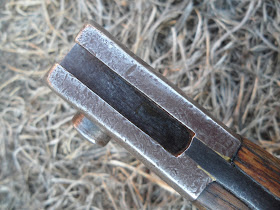Each of these bayonets are currently paired with one of my Turkish Mausers. They are both "Model 1935" bayonets that were made by Turkey for their "Model 1938" Mausers. The "Model 1938" Mausers cover all of the " Turkified" (converted and rebuilt), Model 1883, 1903, and later Mausers that were rebuilt to the "1938 standard". This basically means that they will fit virtually any of the standard Turkish Mausers in use until the 1970's.
In the mid-1930's, Turkey started a program of rebuilding and converting all of their existing rifles to fire the new 8mm rifle round, and at the same time they standardized all of the Mausers to one standard Turkish configuration. This configuration is known today as the "Model 1938". This model name was assigned by the US firearms companies that began importing the surplus Turkish Mausers starting in the 1970's. "Model 1938" was never an actual Turkish designation.
Along with standardizing the rifles, Turkey also came up with a "standard bayonet". This is known as the "Model 1935" Turkish Bayonet.
The "Model 1935" bayonets are anything but standard. They all have very common features and dimensions, but they are definitely not all the same. The Turks converted their existing stocks of their old 1890 and 1903 long bayonets, along with other captured foreign bayonets, and foreign purchased bayonets (often surplus) from countries like Romania, Czechoslovakia, Yugoslavia, Germany, England, Australia, many from the WW1 era............. The old bayonets were chopped, the parts often mixed and matched, the blades reground, the scabbards cut, chopped, modified. After all of this, each bayonet resembled the two bayonets that I am showing today, more or less, often less.
Along with the converted bayonets, they began building their own version of the Model 1935 bayonet in their military arsenals. Out of all of this converting and constructing, the Model 1935 bayonet was born. But even the Turkish made Model 1935 bayonets had wild variations in construction and component details. Basically, every Turkish bayonet is unique, providing nearly endless variety for the collector.
Both of bayonets are marked ASFA, which means "Askari Fabrika", or military arsenal/factory in Turkish. The ASFA arsenal was started in 1929, so any bayonets that do not have this marking are pre-1929. After 1929, all bayonets were stamped with ASFA. Along with the ASFA stamp, both bayonets are serial number marked. There was not a standard location for the ASFA and serial number stamps and both of my bayonets have them in different locations.
Both of my bayonets show "brass fill" in the area of the pommel and the tang. It appears that the parts did not fit consistently or evenly and when the bayonets were assembled, any gaps were just filled by brazing,
Some bayonets had screws holding on the wooden grips and some had rivets.
There are wild variations in the scabbards, and scabbard studs, found on the Model 1935 bayonets. Many scabbards were made new for these bayonets, and many were converted from old scabbards that were much too long and made for older styles of bayonets. The old scabbards were chopped cut, welded, etc. to fit the new pattern blades. These conversions are usually quite crude looking. The standard Turkish scabbard stud was the "single button" type that appears on the rougher of my two bayonets. The bright black scabbard on my second bayonet, is a replacement scabbard, of the German type, that has been re-stamped with the matching bayonet serial number and is not original to the bayonet.
The roughest of my two bayonets is by far the "Classic Turkish" style bayonet. It is "hammered", rough, heavily worn, showing signs of heavy abuse. In fact, my bayonet is actually slightly bent in a slight curve, as if someone made a bayonet charge against a rock wall! The hilt has signs of extended pounding, as if it had been used as a hammer for many years. The "A" on the ASFA stamping has worn completely off. The wooden grips have worn down to the point that the securing rivets are now well above the surface of the wood instead of being recessed! The scabbard is heavily worn, cracked and has an extremely loose stud. Inside the scabbard throat, you can see a deep groove that has been worn into the metal by having blade drawn across it thousands of times through the years. The cross guard is very loose. In short, this is a "typical Turkish bayonet"!
With all of that said, let's take a look at these two bayonets. Enjoy!
BAYONET NUMBER ONE
BAYONET NUMBER 2

























Thank you for your detailed description of the M35 Turkish. I have just acquired an M35 configured for a Garand (I believe). I'm still in the process of taking measurements. All else looks like your bayo #1 except the scabbard has a ball-tip.
ReplyDeleteWhat is the average value of one from 1929
ReplyDeleteI have acquired up being it like your number two is in great condition it is sharp. The scabbard has a ball tip and it fits snug both serial numbers are matching what is something like this worth. You can contact me at 505-712-5605 my name is Philip and I don't do computers very much so a phone call or text would be much better thank you
ReplyDelete